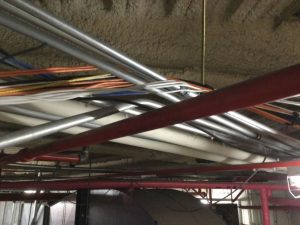April 2023
Inside This Issue
Most Frequently Scored 2022: 
This month’s Perspectives includes a summary of the most frequently scored elements of performance in all accreditation programs for the full calendar year 2022. It is definitely worth your while to review the most frequently scored EPs in each accreditation program in your organization and to assess your level of compliance.
As has been the case for several years now the most frequently scored issue remains performing high level disinfection or sterilization of medical equipment. Overall, the most recent list from 2022 is remarkably similar to the list published last year reflecting 2021 surveys.
One new EP has crept into the top 10 and that is PC.02.01.11, EP 2, dealing with resuscitative equipment, often a failure to perform an inspection or test of the equipment at a frequency defined in hospital policy. Sometimes we see documentation that the equipment and drawer seals were inspected, but the seal serial number doesn’t match, or the equipment log fails to validate that the defibrillator was actually tested as stated.
The hospital safety goal for suicide safety has positions 2, 9 and 10 just like last year, but EPs 4 and 5 have switched positions from 9 and 10, to 10 and 9 respectively. NPSG 15.01.01.01, EP 2 which deals with ligature hazards was scored noncompliant in almost 500 organizations.
This can be a failure to recognize the hazard exists and document it on your risk assessment, or a failure to mitigate or eliminate it. More recently we have started to see more frequent scoring of ligature hazards inside of group rooms and even the nursing station, with surveyors calling for self-closing and locking doors.
The third most frequently scored EP for hospitals is MM.06.01.01, EP 3 which requires that medications be administered per orders and most often this comes up with medication titrations. See the March 2023 Patton Post for more details about titration issues.
Rounding out the top ten most frequently scored issues frequent fliers like EC.02.06.01, EP 1 (the potpourri standard) which requires interior spaces to safely meet patient needs. This is where any torn stretcher cover, damaged wall board, stained ceiling tile or other defects gets scored.
EC.02.05.01, EP 15 holds position 5, just like it did last year, and this is where out of range temperatures, humidity or air pressure relationships get scored. Air pressure relationships remain a key vulnerability as many hospitals have still not provided staff with a gauge, alarm, or simple ball in the wall to determine that the required air pressure is being delivered. This failure to maintain the required air pressure does often appear as a Medicare CoP being scored noncompliant, resulting in a return visit and additional expense.
As you examine potential risk points on your next survey, these heavy hitters are all worth studying and improving. We often get questions from organizations about obscure, seldomly scored standards that organizations are concerned about. This may be because the wording is unclear, or staff have not personally seen this issue scored before. Focusing energy on the most frequently scored issues will have more impact in most organizations.
Sentinel Event Statistics
The April edition of Perspectives has a brief summary of calendar year 2022 sentinel event statistics and a link to their website for a more detailed report. It’s not easy to find when you arrive at their landing page for sentinel events but do look for the report entitled: “Sentinel Event Data 2022 Annual Review.”
This 8-page report summarizes the types of sentinel events reported between 2018-2022. During the last two years, falls have been a huge percentage of total sentinel events as compared to other types of sentinel events. For example, in 2022 falls represented 42% of all sentinel events and the next largest event was delays in treatment, unintended retention of a foreign object, and wrong site surgery, each at 6%. We also noted that suicide represented 5% of all reported sentinel events or 73 total reported suicides.
Given the focus on enhanced suicide screening and reducing ligature hazards in the physical environment, this remains surprisingly high. Couple that fact with the earlier mention of NPSG.15.01.01, EP 1 being the second most frequently scored EP in almost 500 hospitals, and EPs 4 and 5 being the 9th and 10th most frequently scored issues, leaves a lot of room for improvement on suicide prevention. As you consider PI initiatives or your required “proactive intensive analysis,” issues relative to suicide safety might be ideal for examination. (See LD.03.09.01, EP 7 and the introduction to the LD chapter on proactive risk assessment.)
National Practitioner Data Bank Query: 
TJC made a new edit to its standard MS.06.01.05, EP 7 relative to the need to query the National Practitioner Data Bank when evaluating privileges. You might remember that standard MS.06.01.07, EP 9 and MS.07.01.01, EP 3 were recently changed from a 2-year re-privileging cycle to a 3-year re-privileging period.
Perspectives contains a link to the landing page for prepublication standards where you can view the most recent edit. Unfortunately, the change to the EP for NPDB will be unclear to readers as it simply states you must query the NPDB in accordance with law and regulation. However, if you search the NPDB you will see that it has a 2-year requirement to re-query a practitioners file. This requirement is embedded in the social security law under section 1861(e), which also means it is not easily changed.
Reducing Noise: 
The lead article in this month’s EC News discusses techniques that healthcare organizations can do to help reduce noise. It discusses both routine background noise reduction strategies as well as noise mitigation strategies during construction.
The authors mention that OSHA has a requirement to implement a hearing conservation strategy when noise is above 85 decibels averaged over an 8-hour day. They also reference that the EPA recommends continuous background noise in hospitals to be no higher than 45 decibels. The article also mentions specific TJC standards that might provide a basis for again making this a focus of attention.
Construction noise is clearly identified in EC.02.06.05, and interestingly the authors point out EC.02.06.01 which requires a “safe, functional environment.” We discussed standard this in our front-page article on the top ten most frequently scored standards, with EC.02.06.01 being what we called the potpourri standard, where just about any environmental defect can be scored. The authors also advise considering noise in EC.02.01.01, EP 1 which is the requirement for a safety and security risk analysis.
We would not have immediately thought of these two somewhat generic EC standards relative to noise reduction, but we can clearly see the potential applicability. There are eight suggested noise reduction strategies for construction projects that come from ASHE, American Society for Health Care Engineering, which might be good requirement considerations when bidding out a project.
Sprinkler Pipe RFI and ESC: 
EC News has an article following up on their January article about submission of an ESC. This month they provide an example of a completed ESC for LS.02.01.35, EP 4 which prohibits the above ceiling sprinkler pipe from supporting any other material, no matter how light the material is, including cables above the ceiling.
While this particular standard did not make the top ten list in Perspectives, we know it is a very frequent flier because we see it on so many surveys. This example of a completed ESC is helpful in two respects. First, if you have been scored noncompliant on this issue, here is an excellent example of how to document a thorough ESC. More importantly however is, this also provides potential guidance on how to establish a protective process to help avoid getting an RFI for this same issue.
In this example of an ESC, they conducted an analysis process of what was found resting on sprinkler pipe and identified that the hospital IT department and contractors were the most frequent offenders. Then they undertook a series of actions including education of IT and contractors, and development of a work permit for above the ceiling work.
The applicant for the above the ceiling work permit had to read the hospital’s policies on making sure nothing rested on sprinkler pipe and the individual requesting the permit had to read and sign that policy statement. They also educated contractors to include J hooks from the ceiling to create supports for any devices being placed in the ceiling rather than letting these devices touch the sprinkler pipe.
Lastly, they undertook quarterly and annual inspection processes to help identify potential noncompliance with this expectation. Whether you are working on an ESC or just preventative actions this article will be useful to your work.
Alternative Equipment Ma intenance Requirements:
intenance Requirements:
The last article in this month’s edition of EC News discusses alternate equipment maintenance requirements and includes another one of their JCR checklists, should you decide to implement an alternate maintenance program. Equipment maintenance requires a 100% completion rate, which is challenging to hospitals as equipment goes missing at times.
An alternate maintenance program is not a routine schedule, but rather a risk assessment methodology based on manufacturer’s instructions for use, professional literature, and expert advice. While this may allow some more lenient timeframes, it does require a lot of expertise and analysis.
For those organizations that have already implemented an alternative program, the criteria in the checklist are helpful to analyzing your compliance with program requirements. For those that have not implemented any alternative maintenance schedules, the checklist provides good insight into how complex the requirements and process can be and may be helpful to your decision making about potential advantages or disadvantages of alternative schedules.
New Requirements for Certified Community Behavioral Health Clinics:
TJC has developed 81 new  requirements for accredited behavioral health organizations that select the Certified Community Behavioral Health Clinic option during the application process. The CCBHC program is new from the Federal Substance Abuse and Mental Health Services Administration or SAMHSA.
requirements for accredited behavioral health organizations that select the Certified Community Behavioral Health Clinic option during the application process. The CCBHC program is new from the Federal Substance Abuse and Mental Health Services Administration or SAMHSA.
The draft standards from TJC are available from the landing page on prepublication standards, but it looks like you have to complete some marketing information to access them. For those that are interesting in just knowing more about the initiative from SAMHSA you can download their publication at: CBHCC standards: https://www.samhsa.gov/sites/default/files/ccbhc-criteria-2023.pdf
Environmental Sustainability: 
TJC has posted draft standards on environmental sustainability on its website under the category of Field Reviews. A field review allows all of us to review and comment on draft standards prior to finalization. This field review will remain available until May 3rd.
The proposed standard is LD.05.01.01 and it contains four elements of performance. The first EP would require each hospital to appoint an individual responsible for oversight of activities to reduce greenhouse gas emissions. The second EP would require evaluation of three or more of the potential measurement areas in the EP, including energy use, purchased energy including electric and steam, anesthetic gas use, pressurized metered dose inhaler use, fleet vehicle gasoline consumption, and solid waste disposal to landfills.
The field review questions ask for feedback if the EP is clearly written and what barriers you perceive to implementation. There are no field review questions as to whether the draft standards seem unnecessarily proscriptive or the focus on greenhouse gasses is too narrow and at the exclusion of other sustainability and decarbonization activities hospitals may be engaged in or planning. But do take the time to review the draft standards and provide whatever feedback you want.
The field review is located by using the following link. https://jointcommission.az1.qualtrics.com/jfe/form/SV_cMRSo5zW17t26RE
Several months ago in our July 2022 Patton Post, we discussed an EC News article on use of inhaled anesthetic gases with lower carbon footprints that others. This switching of anesthetics is one of the potential projects you can do for this future standard. The American Society of Anesthesiologists has a practice guideline on this issue that you can access using the following link if interested. https://associationofanaesthetists-publications.onlinelibrary.wiley.com/doi/epdf/10.1111/anae.15785
CMS had a busy month with four memos directed to nursing home providers, one memo to hospitals, and one to all providers surveyed for life safety code compliance.
Discontinued Nursing Home Memos: 
Three of the nursing home memos are basically cancelling or expiring memos they had developed during the pandemic. The memos they discontinued include QSO-2026 regarding investigation of Covid cases in nursing homes, QSO 20-39 regarding nursing home visitation, and QSO 20-30 regarding reopening nursing homes.
LSC Memo – Health Care Microgrid Systems:
The life safety code memo QSO-23-11 LSC creates a categorical waiver for healthcare facilities other than nursing homes to create Health Care Microgrid Systems, or HCMSs. HCMSs are basically small-scale electrical grids where sources of electricity can be provided by fuel cells, solar, wind, or energy storage systems. The categorical waiver comes from the requirement that healthcare facilities subject to LSC must adhere to the 2012 NFPA 99 manual.

This requires a normal electrical power source plus an alternate power source which can be a generator or battery system. The 2021 NFPA 99 permits the alternate source of power to include a HCMS. If the HCMS is installed in accordance with 2021 NFPA 99 and 2023 NFPA 70 which establishes requirements for inspection, testing, maintenance, performance, and safe practices, the healthcare facility can use the HCMS under a categorical waiver.
As with all categorical waivers, they must be announced to the surveyors upon arrival, prior to any findings. This categorical waiver is not permitted in nursing homes as the specific regulations for skilled nursing facilities mandate an emergency generator without exception.
Hospital Memo – Appendix A QAPI Modification: 
Probably the most important CMS memo published this past month is QSO-23-09 for hospitals, posted March 9th, 2023. This memo modifies Appendix A for hospitals at the QAPI CoP. CMS identifies in the memo that the QAPI CoP is already the 3rd most frequently scored CoP and with the modifications published in this memo, it is likely to lead to even more frequent scoring on CMS surveys. As is usually done with CMS revisions to the interpretive guidance book, they have highlighted the new content in red, making it easy to see what has changed.
Under tag A-0263, CMS makes it clear that the QAPI program must encompass all locations, all services, and all departments of the hospital, both on campus and off campus. QAPI projects should have the same breadth of scope and must include contracted services. CMS identifies and example of a contracted ED arrangement with the need to demonstrate that quality data is flowing to the QAPI program. CMS includes survey process advice for the surveyors advising them to verify the hospital has an effective, ongoing system in place for identifying problematic events, policies, or practices, and is taking action to remedy them and following up with remedial actions to determine if they were effective in making improvements.
In other words, if you self-identify a problem you need to fix it and validate with hard data or evidence that it has really been fixed. CMS also advises its surveyors that if they uncover significant problems, then they should investigate the effectiveness of the QAPI program. CMS makes it clear to its surveyors that they should not use the hospitals own QAPI data to identify potential findings for their own reports. CMS findings should come from their own chart reviews, not from self-identified problems.
Two guidance-to-surveyor comments stood out in tag A-0273. CMS mentioned their belief that medication error indicator data must demonstrate a decrease in medication errors. Similarly, they stated hand hygiene compliance data must demonstrate increased staff compliance with hand hygiene standards of practice. Both comments stood out to us because we often find hospitals with the least sensitive error identification processes have the best data, and hospitals with the worst data often have the best error identification systems.
For example, self-reported medication error systems that reward staff for completing near miss reports and rigorous reporting of any type of error often have an upward trend as the program grows more robust and staff become more confident in its non-punitive nature. Hand hygiene monitoring where a supervisor stands in the hallway with a clip board to see if staff are gelling in and out demonstrate great compliance because everyone sees the supervisor with the clip board and know they are being monitored. Conversely those hospitals that use the secret shopper process where an individual unknown to the staff is evaluating hand hygiene compliance often have worse data, but more meaningful data of actual care practices.
There are also several references within the memo to ensuring that the governing body is on top of QAPI issues through examination of governing body meeting minutes and even interview of governing body members. One specific reference suggests that governing body members interviewed should be able to provide evidence that improvement activities are actually focused on high volume, high risk and problem prone issues with data on prevalence, incidence and severity.
Lastly, CMS discusses under tag A-0315 the need for surveyors to evaluate the QAPI program to verify it is commensurate with the overall scope and complexity of the services provided by the hospital. More specifically they advise their surveyors to ask for evidence of the resources dedicated to QAPI including staff time, education, and IT support. Quality Directors will want to carefully review this memo, self-evaluate and garner support if needed.
Consultant Corner
Dear Readers,

It comes with a very heavy heart to share the news of the loss of one of our team members, Fred Fehlinger.
Fred came to join Patton in 2021 but quickly turned from colleague to very good friend to the whole team. He was kind, he was funny, and he had a wealth of knowledge beyond compare. He had a true knack for helping people understand how to integrate health care regulation into safe and compliant patient care.
We will deeply miss him and if you have ever known or worked with Fred, you are certainly going to miss his expertise and, most importantly, friendship.
Jennifer Cowel, RN MHSA
JenCowel@PattonHC.com
Julia Finken, RN, BSN, MBA, CPHQ
julia.finken@hbsinc.com
Kurt Patton, MS RPh
Kurt@PattonHC.com
John Rosing, MHA
JohnRosing@PattonHC.com
